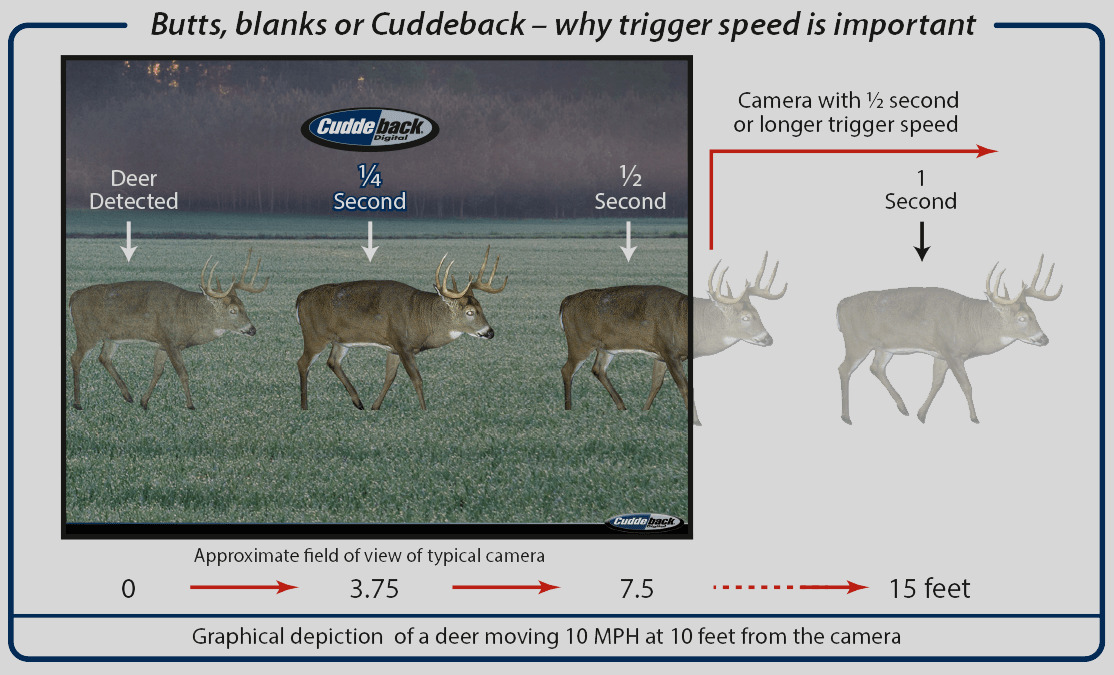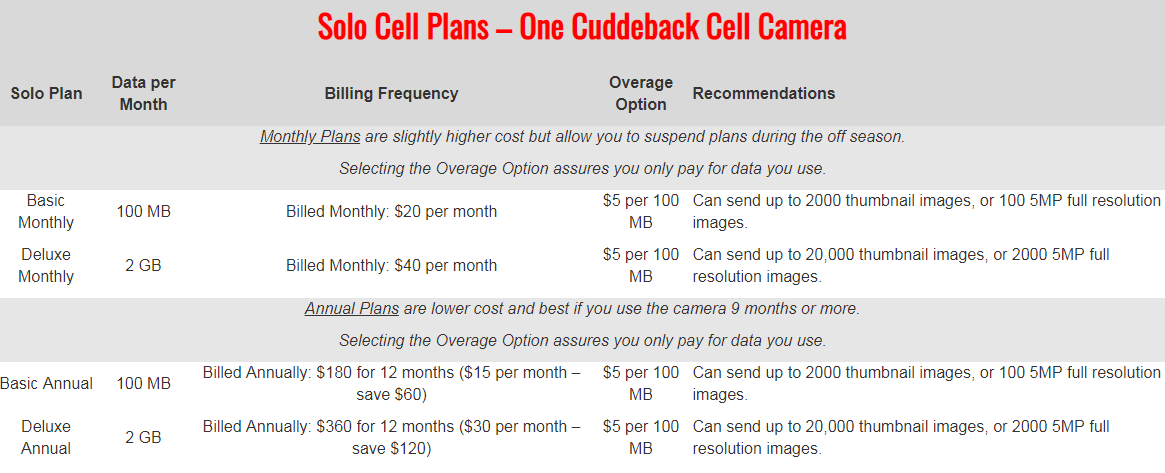When you research trail cameras, a few names appear on almost every list—Browning, Hunting Made Easy, and Stealth Cam to name a few. However, Cuddeback is a key player that consistently wins customers with its price and reliability. In this post, we review Cuddeback’s products, how their systems work, and answer one of the most common questions we receive about these products: which Cuddeback camera should I get?
Cuddeback Camera Comparison
Cuddebacks are not known for having a lot of fancy add-ons, but they do the basics very well. They’re affordable, reliable, and have a consistent trigger speed of .25-.5 seconds. That said, there are a few key differences between the different grades of Cuddeback trail cameras.
| CuddeLink Dual Flash 20MP Model G-5055 | CuddeLink Black Flash Model J-1422 | CuddeLink Long Range IR Model J-1415 | Cuddeback X-Change Trail Camera (Blue) | Cuddeback CuddeLink G Series Trail Camera | CuddeLink Power House IR 20MP | |
| Trigger Speed | .25 seconds | .25 seconds | .25 seconds | .25 seconds | .25 seconds | .25 seconds |
| Image Quality | 20MP | 20MP | 20MP | 20MP | 20MP | 20MP |
| Flash Range | 100+ feet | 50+ feet | 100+ feet | 100+ feet | 100+ feet | 100+ feet |
| Flash Type | No-glow & low-glow IR with 28 940nm LEDs | No glow IR with 940nm LEDs | Infrared with 850nm LEDs | Color, Infrared, or Black | Color strobe with 570uF | Power House IR (3x power of normal LEDs) |
| Battery Life | 6 months | 6 months | 6 months | 12 months | 12 months | 12 months |
| Interchangeable Flash | ✔ | |||||
| Waterproof | ✔ | ✔ | ✔ | ✔ | ✔ | ✔ |
| Shoots Video | ✔ | ✔ | ✔ | ✔ | ✔ | ✔ |
| Day & Night Modes | ✔ | ✔ | ✔ | ✔ | ✔ | ✔ |
| Time Lapse | ✔ | ✔ | ✔ | ✔ | ✔ | ✔ |
| EZ, Advanced & Survaliance Modes | ✔ | ✔ | ✔ | ✔ | ✔ | ✔ |
| CuddeLink On-Site Compatible | ✔ | ✔ | ✔ | ✔ | ✔ | ✔ |
| CuddeLink Cell Compatible | ✔ | ✔ | ✔ | ✔ | ✔ | ✔ |
| Price | $199.99 | $199.99 | $199.99 | $199.99 | $199.99 | $285.00 |
What Makes Cuddebacks different?
Battery Power & Durability
You can mount Cuddebacks to trees and leave them to record uninterrupted for a range of 6-12 months depending on your preferred model. However, if you’re in a position where you can’t (or don’t want to) regularly update the batteries, you can add a Cuddeback CuddePower Battery Booster or Cuddeback J Camera D Battery Adapter. This compact add-on gives four times the power provided by the 8 AA batteries in the camera itself. It’s also an asset if you’re using your Cuddeback in freezing and subfreezing temperatures which can drain batteries faster than use in a more temperate climate.
Cuddeback gear is designed to weather the great outdoors. As a result, all of the brand’s cameras are waterproof. However, some Cuddeback customers don’t deal with “normal” weather patterns. Instead, they’re contending with the harshest cold and most scorching heat on the planet. For those users, we recommend adding a Cuddeback camera case to your setup. It’s not only an extra layer of protection from excessive snow, rain, and heat but also some of your camera’s more aggressive subjects.
Mesh Networking
One of Cuddeback’s biggest selling points is that their cameras are connected with a wireless mesh network; they call it CuddeLink. In short, this system lets you check up to 15 Cuddeback cameras that are monitored from one hub; that hub can either be a “home” camera or your email inbox. As a result, you don’t have trek miles through your property and leave your scent behind when checking individual devices.
Transmission Distance
The average transmission distance between two cameras in a densely wooded area is ¼ to ½ mile. In open areas, CuddeLink has a camera-to-camera range of a little over 1 mile. However, if you invest in more than two devices, you can extend your signal much further—the cameras daisy-chain together and can cover a distance of over 4 miles.
A word to the wise, these are the average ranges and the numbers will vary a little based on the elevation of surrounding terrain and the presence of extreme weather conditions. If you want to be extra sure that your cameras will always be in communication, you can add an antenna like this one for the Dual Flash 1361. Keep this in mind when planning your setup.
Connectivity
CuddeLink caters to people that live near the land their monitoring as well as those who are keeping an eye on things from a different geographic location. They have two options based on your situation: On-Side and Cell.

CuddeLink On-Site
CuddeLink On-Site is for hunters or landowners living on or near their property. Let’s say you have the maximum number of 15 cameras spread out over miles of land. Rather than spending your entire day going to each camera individually, the system automatically sends the images taken on all 15 devices to one designated Cuddeback “home” receiver. There, they are saved to a single SD card that can be taken out and unloaded onto your computer.
CuddeLink Cell
Option number two is CuddeLink Cell. Cell and On-Site work the same way: you have multiple connected cameras that send their images to one convenient place. However, you don’t have to go retrieve an SD card to view them; they are automatically sent to your email inbox.
This is objectively the more convenient option for Cuddeback users. Rather than shuffle out to a camera in the freezing cold to retrieve an SD card, you can just glance at your computer or smartphone. However, this convenience does not come for free: CuddeLink Cell has a monthly fee. It works off of a proprietary cellular system that allows Cuddeback to communicate through an LTE home unit and billing is based on data usage.
The plan information is listed below. Compared to typical data plans, it’s very affordable.

Ease of Use
Perhaps most importantly, Cuddeback products are incredibly easy to use. After all, all of this useful tech doesn’t mean a thing if users can’t figure out how it works. The camera interface is simple and intuitive and there aren’t a lot of unnecessary bells and whistles. Plus, Cuddeback does a great job providing set-up videos like the one below.





























